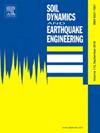输电塔线系统颗粒阻尼器抗震性能的实验与数值研究
IF 4.2
2区 工程技术
Q1 ENGINEERING, GEOLOGICAL
引用次数: 0
摘要
针对传统调谐质量阻尼器(TMDs)在地震作用下控制输电塔结构下部高频振动的局限性,采用粒子阻尼器(pd)控制输电塔-线系统的地震响应。通过振动台试验,比较了PD和TMD的控制效果。考虑到多粒子碰撞的非线性和传输系统的塔线耦合效应,建立了基于ABAQUS的离散元-有限元耦合仿真方法。通过实验验证了PD的仿真方法和鲁棒性。结果表明,在辅助质量相当的情况下,PD在带宽上优于TMD。地震激励的时变和空变特性会影响TMD的性能。相反,由于PD具有非线性阻尼能力,可以更有效地抑制下部的加速度响应,减少上部的变形。这使得PD成为TTLS振动控制的一个更强大的选择。本文章由计算机程序翻译,如有差异,请以英文原文为准。
Experimental and numerical study on the seismic mitigation performance of particle dampers on transmission tower-line system
To address the limitation of traditional tuned mass dampers (TMDs) in controlling high-frequency vibrations at the lower part of transmission tower structures under earthquakes, this study adopts particle dampers (PDs) to control the seismic response of the transmission tower-line system (TTLS). A shaking table test is conducted on a scaled model of the TTLS to compare the control effects of PD and TMD. A discrete-element-finite-element coupling simulation method using ABAQUS is developed to model the TTLS with PD, accounting for the nonlinearities from multiple particle collisions within the PD and the tower-line coupling effect in the transmission system. The simulation method and the robustness of the PD are validated through the experiments. The results indicate that PD outperforms TMD in bandwidth with comparable auxiliary mass. The performance of TMD can be affected by the space-varying and the time-varying characteristics of seismic excitations. In contrast, due to the non-linear damping capability, PD suppresses acceleration responses in the lower part more effectively and reduces deformations in the upper part of the transmission tower. This makes PD a more robust option for the vibration control of TTLS.
求助全文
通过发布文献求助,成功后即可免费获取论文全文。
去求助
来源期刊

Soil Dynamics and Earthquake Engineering
工程技术-地球科学综合
CiteScore
7.50
自引率
15.00%
发文量
446
审稿时长
8 months
期刊介绍:
The journal aims to encourage and enhance the role of mechanics and other disciplines as they relate to earthquake engineering by providing opportunities for the publication of the work of applied mathematicians, engineers and other applied scientists involved in solving problems closely related to the field of earthquake engineering and geotechnical earthquake engineering.
Emphasis is placed on new concepts and techniques, but case histories will also be published if they enhance the presentation and understanding of new technical concepts.
 求助内容:
求助内容: 应助结果提醒方式:
应助结果提醒方式:


